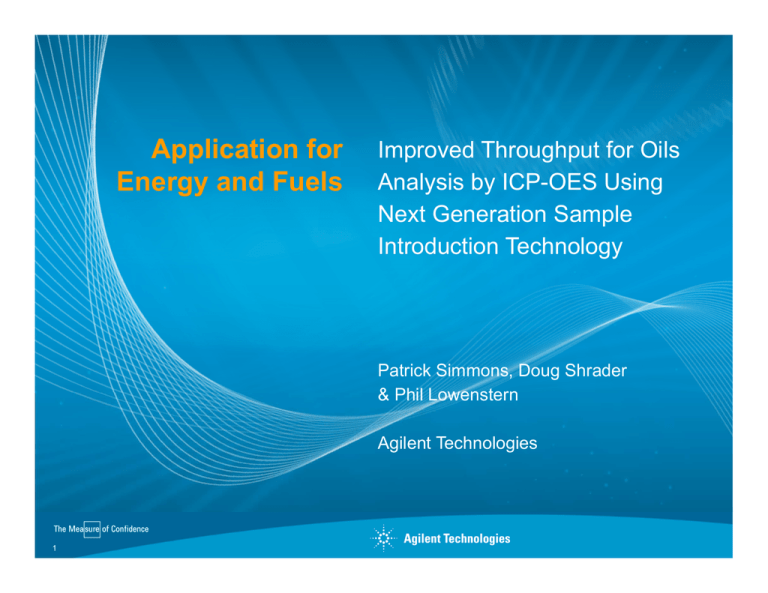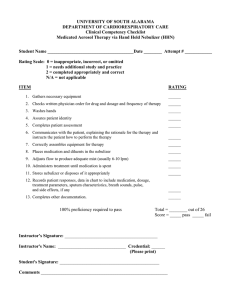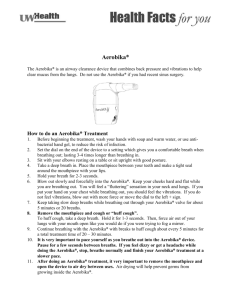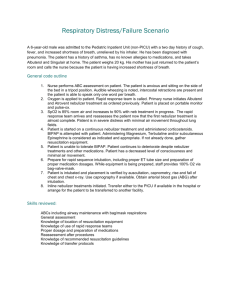Nebulizers - Agilent Technologies
advertisement

Application for
Energy and Fuels
Improved Throughput for Oils
Analysis by ICP-OES Using
Next Generation Sample
Introduction Technology
Patrick Simmons, Doug Shrader
& Phil Lowenstern
Agilent Technologies
1
Overview
Application Considerations
Applications
• Biodiesel
• Petroleum diesel and coolant analysis
• Naptha
• Wear metals – High Throughput Analysis
Conclusions
2
Application Considerations
The challenge:
•
High vapour pressure from solvents
–
–
•
Carbon build up on injector
–
–
•
Poor precision and drift
Down time - injector requires regular cleaning
Nebulizer blockage
–
–
3
Plasma instability
Extinguished plasma
Poor precision
Down time - nebulizer needs cleaning
Application Considerations
The solution:
•
Carbon build up
– Use radially viewed vertically oriented plasma
•
–
–
Exhaust positioned directly above plasma, efficiently extracts carbon
by-products
Use oxygen addition into auxiliary gas flow to facilitate removal of
carbon and reduce background
•
•
Mandatory with axial ICP
Nebulizer blockage
– Use nebulizer with large ID to reduce blockage from particulates
•
–
–
e.g. SeaSpray, Slurry or V-groove nebulizer
Use new OneNeb nebulizer
Filter samples or allow to settle and sample from the top
•
4
Minimizes carbon build-up
Conikal nebulizer produces finer aerosol
One Piece Torches
Radial ICP Torches
• Designed specially for organic solvents
• Annealed for greater durability
• Choice of 0.8 and 1.4mm ID. injector
– 1.4 mm ID suitable for organic solvents of low to
moderate volatility
– 0.8 mm ID suitable for highly volatile organic solvents
5
Nebulizers
•
•
•
Sample particulates may block standard
concentric nebulizers
–
Dependent on sample composition
e.g. wear metal particulates
–
Poor precision
–
Down time - nebulizer needs cleaning
Quartz nebulizer
Quartz nebulizer
–
Conikal, Seaspray and Slurry
–
Faster washout
V-groove nebulizer
–
Made of PEEK polymer
–
Minimizes particulate blockage
V-groove nebulizer
6
For Challenging Applications
– OneNeb Nebulizer
• Robust PFA and PEEK construction
– Inert - resistant to strong acids such as HF
– Resistant to breakage
– Molded plastic design provides improved
nebulizer to nebulizer reproducibility
• Constant diameter narrow bore tubing
through to nebulizer tip
– Ideal for high solids/particulates
– Improved tolerance to high TDS samples
• Narrow aerosol size distribution provides
improved precision
• Handles a wide flow range from 0.1 to 2
mL/min.
– No sensitivity loss at low flow rates
7
Principle of Operation – Inert OneNeb Nebulizer
Tip geometry dimensioned to allow carrier
gas to mix with the sample
Turbulent mixing of liquid and gas occurs
• Produces aerosol with a narrow size
distribution range
Droplets mixed into gas flow
No area of low pressure
Unique Flow Blurring action increases
nebulization efficiency
• Greater efficiency than conventional
concentric nebulizer
• Improved sensitivity
Proportion of Total
14
Inert OneNeb nebulizer
12
10
8
Conventional concentric nebulizer
6
4
2
0
0
20
40
60
Droplet Size (m)
8
80
100
Spray Chambers
•
Double-pass glass cyclonic spray
chamber
–
–
–
–
–
•
Cooled spray chamber
–
–
–
–
–
9
Double pass design
Reduces solvent load
Increased sensitivity
Fast washout
Suitable for low vapour organic solvents
Externally jacketed or Peltier cooled designs
Can cool sample to -10 oC or lower
Reduces solvent load
Made of quartz
Excellent for highly volatile organic solvents
e.g. naphtha
Compatibility of Pump Tubing
Pump Tubing
Solvent
PVC
Viton
PVC Solva
Kerosene
Gasoline
Fuel
Coolant
N/A
= unsatisfactory, = satisfactory, N/A = no data available
10
Application Considerations
The challenge:
•
Various elements of interest
–
•
Unknown concentration of analytes in samples
–
•
Down time – to perform multiple dilutions for the same sample
Difficult interferences to overcome
–
11
May need to calibrate for 30 to 60 different elements
Poor accuracy
Measuring Petroleum Products Successfully
The solution:
•
Linear dynamic range
–
–
•
Structured backgrounds
–
–
•
Radial ICP-OES
Use patented Fast Automated Curvefitting Technique (FACT)
Speed of analysis
–
–
12
Use wavelength flexibility to extend the
upper limit
Still achieve best detection limits
725 simultaneous CCD system
Fastest possible read out speed
700 Series Optical Design
Echelle Optical Design
Full wavelength coverage
– Maximum flexibility for extended linear working range
– Elimination of spectral interferences
All wavelengths captured in one reading
– Maximum speed and productivity
Fewer optical components
– Excellent signal-to-noise
– Lowest detection limits
Thermostatted to 35oC
– Excellent long term stability
– Fast start-up, increasing sample throughput
13
World’s Most Innovative Detector
•
725 Patented custom-designed CCD
• Continuous Wavelength coverage
• 167 – 785 nm
• Simultaneous measurement
• Very high Quantum Efficiency
• Excellent resolution
• Lower detection limits
• Dual mode anti-blooming capabilities
• Eliminates blooming in both the X and Y direction
•
14
Peltier cooled for lowest noise and best detection limits
Structured Background
Introduction of organic solvents into the ICP can result in
spectral interferences from molecular emission by species
such as C2 and CN
• Na 589nm in engine oil and diluted in white spirit
Blank – 0 mg/kg Na
15
Standard – 10 mg/kg Na
Structured Background from Na 589 nm in Oil
- Diluted in white spirit
16
Blank – 0 mg/kg Na
Blank – 0 mg/kg Na
- No Background Correction
– Fitted Background Correction
Structured Background from Na 589nm in Oil
- Diluted in white spirit FACT Corrected
Background
Sample Spectrum
Analyte
Blank – 0 mg/kg Na
17
Standard – 10 mg/kg
Structured Background from Na 589nm in Oil
- Diluted in white spirit FACT Corrected
18
Sample and Standard Preparation
Sample Preparation
• Up to 1 in 10 dilution on a weight per
volume basis
• Use suitable organic solvent
e.g. xylene, kerosene, Shellsol
Standard Preparation
• Multi-element organometallic standard
(e.g. Conostan S-21)
• Select dilution ratio to achieve required
concentration
• Add extra neutral base oil (No. 75) to
ensure consistent viscosity
19
Typical Instrument Conditions
Plasma power
1.3 - 1.5kW
Plasma gas flow
15 – 18 L/min
Auxiliary gas flow
0.75 – 2.25 L/min
(axial – radial)
Nebulizer gas flow (axial)
Optimize
(0.5 – 0.8 L/min)
Nebulizer gas flow (radial)
Set bullet to top of torch
(0.5 – 0.8 L/min)
20
AGM-1 setting
2-6
Stabilization delay
Optimize via time scan
Pump speed
5 - 10 rpm
Uptake Rate
< 1 mL/min
Fast Pump
Yes or No?
Important Parameters
Parameters:
•
Power 1.3 - 1.5 kW
•
Nebulizer flow: optimize using
bullet of the plasma
•
Viewing height: optimized for
SBR
Each can be automatically
optimized using AutoMax
21
Why Optimize?
Power = 1.2 kW
Nebulizer flow = 1.00L/min
Viewing height = 10mm
22
Power = 1.5 kW
Nebulizer flow = 1.70L/min
Viewing height = 5mm
Performance Test – Linear Range
Radial, S21 Conostan Oil Standards in Kerosene
23
ICP-OES Accessories Overview
SPS-3 =
Autosampler
for automated
sample
presentation
ASA = Increases the
water vapor in the
nebulizer gas
24
AGM-1 =
Addition of
oxygen to
plasma
SVS-2 = Increased
productivity and more
efficient washout
VGA-77P = for hydride
determinations of As, Se &
Hg (ppb levels)
Direct Biodiesel Fuel Analysis
25
Why Use Biodiesel?
• Reduced dependence on imported oil
products
– Direct replacement for conventional
petroleum based diesel fuel
– Important alternative fuel source
• Biodiesel is a green fuel
– Produced from domestic, renewable
resources
– Biodegradable and non-toxic
– Reduction in pollutants such as
sulfur and aromatics
– 78 % reduction in CO2 emissions
compared with petroleum
26
Analytical Results
– ASTM D6751 Specified Elements in Biodiesel
Element
P
S
Na
K
Ca
Mg
213.618
181.972
589.592
766.491
393.366
279.553
B‐100a ppm
< IDL
1.695
0.162
0.507
0.013
0.011
B‐100b ppm
< IDL
1.710
0.130
0.469
0.012
0.012
B‐100+1.0 ppm (%R)
105
103
104
107
105
104
B‐100+2.5 ppm (%R)
102
106
102
104
103
101
IDL (ppb)
19.9
76.5
4.1
21.8
0.1
0.1
Fitted
Fitted
FACT
FACT
Fitted
Fitted
Wavelength (nm)
Bkgd Correction
27
Direct Measurement of Petroleum
Diesel and Coolant Samples
28
Detection Limits – Petroleum Diesel
29
Stability – Petroleum Diesel
Ag 328.068
1.2
Al 396.152
B 249.772
1
Ba 455.403
Ca 396.847
0.8
Cd 214.439
Cr 267.716
0.6
Cu 327.395
Fe 238.204
Mg 279.553
0.4
Mn 257.610
Mo 202.032
0.2
Ni 231.604
P 213.618
30
:0
:1 5
21 3:1
:3 0
21 0:1
:4 4
22 7:2
:0 0
22 4:2
:2 5
22 1:3
:3 2
22 8:3
:5 8
5:
45
21
:5
6
:0
0
20
:3
9
:5
6
20
:2
1
:5
2
20
:0
4
:4
7
20
:4
7
:4
4
19
19
:3
0
:4
2
Pb 220.353
:1
3
19
18
:5
6
:3
9
0
S 180.669
S 181.972
S 182.562
Plasma Stability
Ag 328.068
8 Hour Stability Run - NO Int. Std.
Worksheet S21Stab7.vws
Al 396.152
Ba 455.403
10
Ca 396.847
Cd 214.439
9
Cr 267.716
Cu 327.395
8
Concentration (ppm)
Fe 238.204
7
Mg 279.553
Mn 257.610
6
Mo 202.032
Na 588.995
5
Na 589.592
Ni 231.604
4
P 213.618
3
Pb 220.353
Si 251.611
2
Sn 189.927
Ti 336.122
1
0
0:00
V 292.401
Zn 213.857
1:12
2:24
3:36
Time (Hrs:Min)
4:48
6:00
7:12
90 % Limit
110 % Limit
Eight hour stability run for elements in oil/kerosene - Conostan S21
31
Determination of Trace Elements in Naphtha
Michelle Morin, Natural Resources Canada
Wayne Blonski, Agilent Technologies, Mississauga, Ontario, Canada
32
Why Determine Trace Elements in Naphtha?
Naphtha is a liquid intermediate
between the light gases in the crude
oil and the heavier liquid kerosene
and are:
• Volatile
• Flammable, and
• Have a low specific gravity of about 0.7
The presence of trace metals in
hydrocarbon samples can:
• Severely hamper the catalytic
reforming process
• Poison the catalysts used
e.g. S and N compounds can
deactivate catalysts
Catalysts used in catalytic cracking or reforming
Photo courtesy Phillips Petroleum Company
33
Performance Test - Plasma Stability
7
Ni 231.604
Ni 216.555
Mg 279.553
V 309.310
V 292.401
Mg 280.270
Al 396.152
Ca 396.847
Ca 422.673
Cd 214.439
Cd 226.502
Cd 228.802
Cr 267.716
Cu 324.754
Cu 327.395
Fe 238.204
Fe 259.940
Mn 257.610
Na 588.995
Na 589.592
6.5
6
Concentration
5.5
5
4.5
4
3.5
3
1:1 1:2 1:3 1:4 1:5 1:6 1:7 1:8 1:9
1:
10
1:
11
1:
12
1:
13
1:
14
1:
15
1:
16
1:
17
No. Samples Measured
Short term stability over 30 mins. for Naphtha
34
1:
18
1:
19
1:
20
Detection Limit Performance (mg/L)
35
Wear Metals Analysis
A High Throughput Application
36
Accuracy
CRM Analysis 1084a Wear metals in lubricating oil
Elements &
Wavelength
(nm)
Results
(ppm)
CRM 1084a
(ppm)
%
Recovery
Ag 328.068
Al 167.019
Cr 267.716
Cu 327.395
Fe 238.204
Mg 279.553
Mo 202.032
Ni 231.604
Pb 220.353
S 181.972
Si 251.611
Sn 189.927
Ti 336.122
V 292.401
96.3
105.6
96.9
99.1
100.6
100.6
96.6
99.5
107.7
2022
100.7
91.5
101.3
101.3
101.4
104
98.3
100
98.9
99.5
100.3
99.7
101.1
1700
103
97.2
100.4
100.4
95
102*
99
99
102
101
96
100
107
119**
98*
94
101
101
* Uncertified results
** Uncertified results, result was high because of kerosene contamination
37
Plasma Stability
Ag 328.068
8 Hour Stability Run - NO Int. Std.
Worksheet S21Stab7.vws
Al 396.152
Ba 455.403
10
Ca 396.847
Cd 214.439
9
Cr 267.716
Cu 327.395
8
Concentration (ppm)
Fe 238.204
7
Mg 279.553
Mn 257.610
6
Mo 202.032
Na 588.995
5
Na 589.592
Ni 231.604
4
P 213.618
3
Pb 220.353
Si 251.611
2
Sn 189.927
Ti 336.122
1
0
0:00
V 292.401
Zn 213.857
1:12
2:24
3:36
Time (Hrs:Min)
4:48
6:00
7:12
90 % Limit
110 % Limit
Eight hour stability run for elements in oil/kerosene - Conostan S21
38
Introduction
In order to predict when equipment maintenance may be required or to
prevent having to perform maintenance, lubricating oils in equipment are
regularly analyzed to monitor changes in levels of wear-metals, and additive
and contaminant elements. The analyst is mainly interested in trending
changes over time, not exact values. So high sample throughput could be
considered more important than accuracy, precision, long-term stability and
repeatability/reproducibility.
In this work, an Agilent 725 Series ICP-OES inductively coupled plasma
optical emission spectrometer with Agilent SPS 3 Sample Preparation
System and Agilent SVS 2 Switching Valve System was used. The SVS 2
improves efficiency by greatly reducing sample uptake and washout times.
The typical ICP-OES sample analysis cycle time was halved (to 33 seconds
per sample), significantly reducing operating costs, without compromising
accuracy, precision, long-term stability and repeatability/reproducibility.
39
Measurement challenge
Challenge
While long-term stability and repeatability/reproducibility are important in wear-metal
analysis, since analytical results are used only for trend analysis, accuracy becomes
a less important factor and sample throughput is often the most critical consideration.
Solution
Using the Agilent SVS 2 Switching Valve System with an Agilent 725 Series radiallyviewed ICP-OES and Agilent SPS 3 Sample Preparation System more than halves
the sample analysis cycle time of about 90 seconds without the SVS 2, to about
33 seconds per sample using the SVS 2, without compromising accuracy, precision or
stability.
40
Experimental
Instrumentation
• Instrument: Agilent 725 Series simultaneous ICP-OES with radially-viewed
plasma.
• Accessories: Agilent SPS 3 Sample Preparation System; Agilent SVS 2
Switching Valve System.
Switching Valve System 2
Increase Productivity
725 ICP-OES
41
•
Higher sample throughput
•
Decreased wear and tear on
nebulizer/spraychamber/torch
•
Lower operating cost through
reduced argon use
SVS Productivity Packages
How does it work?
Comparison of the sample uptake, measurement and rinse profiles of 100 mg/L manganese
without a SVS and the SVS 2. The data shows a dramatic increase in productivity while
maintaining consistent data quality.
42
SVS 2 Switching Valve System
Second Generation Switching Valve
SVS 2 in Sample Load Position
Load
43
SVS 2 in Sample Inject Position
Analyze
Experimental
Instrumentation
Agilent 725 Series ICP-OES instrument operating parameters
Condition
Power
Plasma gas flow rate
Auxiliary gas flow rate
Spray chamber
Torch
Transfer tube
Nebulizer
Nebulizer flow rate
Viewing height
Pump tubing
Pump speed
Total sample usage
Replicate read time
Number of replicates
Sample uptake delay
Stabilization time
Rinse time
Fast pump
Background correction
Setting
1.35 kW
15 L/min
2.25 L/min
Glass cyclonic double-pass (Twister)
One-piece quartz radial (1.5 mm id injector)
Glass
Glass concentric (SeaSpray)
0.55 L/min
9 mm
Rinse/instrument: Gray/gray SolventFlex (1.30 mm id)
Waste: Purple/black SolventFlex (2.29 mm id)
12 rpm
2 mL
2s
3
0s
12 s
0s
Off
Fitted
Note: An all-glass sample introduction system (part number 9910117900) was used.
44
Experimental
Instrumentation
Agilent SVS 2 Switching Valve System operating parameters
Condition
Loop uptake delay
Uptake pump speed — refill
Uptake pump speed — inject
Sample loop size
Time in sample
Bubble inject time
Setting
7s
500 rpm
150 rpm
0.5 mL
6s
6.9 s
Note: The internal standard/diluent channel was not used.
45
Experimental
Standard and sample preparation
Calibration solutions of 0, 5, 10, 25 and 50 mg/L were prepared from
Conostan S-21 + K certified standard, which contains 22 elements (Ag, Al,
B, Ba, Ca, Cd, Cr, Cu, Fe, K, Mg, Mn, Mo, Na, Ni, P, Pb, Si, Sn, Ti, V and
Zn) at 500 mg/kg in oil. These calibration solutions were viscosity matched
using Conostan Element Blank Oil (75 cSt) and diluted with kerosene to
give a total oil concentration of 10 % (w/v) in each solution.
Duplicate 0.5 g portions of NIST SRM 1084a (Wear-Metals in Lubricating
Oil) and 2 g of Element Base Oil were accurately weighed into 25 mL
volumetric flasks and made up to volume with kerosene. A third 0.5 g
portion was similarly prepared, spiked with S-21 + K standard.
Duplicate 0.5 g portions of NIST SRM 1085b (Wear-Metals in Lubricating
Oil) and 4.5 g of Element Base Oil were accurately weighed into 50 mL
volumetric flasks and made up to volume with kerosene.
46
Experimental
3σ method detection limits (MDLs) & linearity correlation coefficients
Element &wavelength
Ag 328.068
Al 308.215
B 249.678
Ba 493.408
Ca 422.673
Cd 228.802
Cr 205.560
Cu 327.395
Fe 259.940
K 766.491
Mg 285.213
Mn 260.568
Mo 204.598
Na 588.995
Ni 230.299
P 177.434
Pb 283.305
Si 251.611
Sn 283.998
Ti 334.941
V 292.401
Zn 213.857
47
MDL (mg/L)
0.003
0.018
0.011
0.002
0.008
0.005
0.010
0.007
0.004
0.081
0.006
0.004
0.015
0.062
0.018
0.069
0.031
0.101
0.128
0.002
0.003
0.015
Element &wavelength
Ag 328.068
Al 308.215
B 249.678
Ba 493.408
Ca 422.673
Cd 228.802
Cr 205.560
Cu 327.395
Fe 259.940
K 766.491
Mg 285.213
Mn 260.568
Mo 204.598
Na 588.995
Ni 230.299
P 177.434
Pb 283.305
Si 251.611
Sn 283.998
Ti 334.941
V 292.401
Zn 213.857
r2
0.9998
0.9998
0.9998
0.9996
0.9996
0.9999
0.9999
0.9997
0.9999
0.9996
0.9998
0.9998
0.9999
0.9999
0.9999
0.9999
0.9997
0.9999
0.9999
0.9997
0.9999
0.9999
Results
NIST SRM 1084a
Wear-metals in lubricating oil – sample source NIST US Department of Commerce.
Note: Values in parentheses “()” not certified (information only).
Element &
wavelength
Ag 328.068
Al 308.215
Cr 205.560
Cu 327.395
Fe 259.940
Mg 285.213
Mo 204.598
Ni 230.299
Pb 283.305
Si 251.611
Sn 283.998
Ti 334.941
V 292.401
48
Certified
(mg/kg)
101.4
(104)
98.3
100.0
98.9
99.5
100.3
99.7
101.1
(103)
97.2
100.4
95.9
Found
(mg/kg)
100.3
99.7
104.3
102.7
105.2
102.5
106.2
106.2
103.1
100.2
105.8
105.2
105.4
Duplicate
(mg/kg)
101.1
100.4
105.5
103.6
105.4
102.9
106.3
107.0
105.7
100.4
105.6
105.2
105.9
Recovery
(%)
98.9
95.9
106.1
102.7
106.4
103.0
105.9
106.5
102.0
97.3
108.8
104.8
109.9
RPD dup.
(%)
0.9
0.7
1.2
0.8
0.2
0.4
0.1
0.7
2.5
0.2
0.2
0.0
0.4
Spike level
(mg/L)
2.17
2.17
2.17
2.17
2.17
2.17
2.17
2.17
2.17
2.17
2.17
2.17
2.17
Recovered
(mg/L)
2.27
2.27
2.27
2.27
2.25
2.28
2.28
2.28
2.30
2.31
2.31
2.27
2.30
Recovery
(%)
104.6
104.3
104.3
104.5
103.5
104.9
104.9
104.9
105.9
106.1
106.3
104.5
106.0
Results
NIST SRM 1085b
Wear-metals in lubricating oil — sample source NIST US Department of Commerce.
Note: Values in parentheses “()” not certified (information only), values in brackets “{}” not certified (reference only).
Element & wavelength
Ag 328.068
Al 308.215
B 249.678
Ba 493.408
Ca 422.673
Cd 228.802
Cr 205.560
Cu 327.395
Fe 259.940
Mg 285.213
Mn 260.568
Mo 204.598
Na 588.995
Ni 230.299
P 177.434
Pb 283.305
Si 251.611
Sn 283.998
Ti 334.941
V 292.401
Zn 213.857
49
Certified (mg/kg)
304.6
{300.4}
(300)
(314)
(298)
302.9
302.9
295.6
{301.2}
297.3
(289)
(296)
305.2
295.9
{299.9}
297.7
{300.2}
(294)
{301.1}
297.8
296.8
Found (mg/kg)
307.0
300.8
312.4
331.3
292.7
305.1
324.1
303.0
310.7
303.6
291.3
312.7
299.4
315.5
317.0
308.7
315.1
317.2
311.5
309.1
308.8
Duplicate (mg/kg)
315.9
306.6
327.8
339.1
300.6
310.8
329.7
311.1
316.9
309.8
296.8
317.8
309.7
319.7
317.4
313.2
314.8
322.7
317.2
314.5
314.9
Recovery (%)
100.8
100.1
104.1
105.5
98.2
100.7
107.0
102.5
103.1
102.1
100.8
105.6
98.1
106.6
105.7
103.7
105.0
107.9
103.5
103.8
104.1
RPD dup. (%)
2.9
1.9
4.9
2.4
2.7
1.8
1.7
2.7
2.0
2.1
1.9
1.6
3.5
1.3
0.1
1.5
0.1
1.7
1.8
1.8
2.0
Results
System stability
50
Experimental
Washout / carryover & speed of analysis
Washout/carryover
Blank measurement
1
2
3
4
Ba 493.408
0.039
0.039
0.052
0.050
Ca 422.673
0.047
0.032
0.034
0.034
Carryover (% of standard concentration)
Fe 259.940
Cu 327.395
0.035
0.043
0.032
0.046
0.035
0.039
0.038
0.040
Mg 285.213
0.045
0.057
0.058
0.047
Speed of analysis
Tube-to-tube analysis time averaged 33 seconds, equating to > 100
samples/hour.
51
Zn 213.857
0.027
0.026
0.037
0.037
SVS 2 Results Summary
• Were able cut the sample analysis cycle time from about 90
seconds to about 33 seconds per sample using the SVS 2,
without compromising accuracy, precision or stability.
• “Dead time” is eliminated (sample uptake, stabilization and
washout times)
• SVS 2 utilizes stacked switching valves, sample loop and
high speed, positive displacement motor
• Constant solution flow improves plasma stability
• Sample never contacts pump tubing, inert sample path
reduces sample carryover
52
Application Papers
Available on the Agilent Technologies Web site
(http://www.agilent.com)
•
SI-A-1413
Determination of metals in oils by ICP-OES
•
SI-A-1417
Determination of V, Ni and Fe in crude oils and bitumen with Sc
as an internal standard
•
SI-A-1420
Determination of wear metals in lubricating oil with Axial ICP
•
SI-A-1422
Determination of Pb in Unleaded Gasoline with Axial ICP
• SI-A-1423
Determination of trace elements in a xylene solution of oil by
ICP-AES with ultrasonic nebulization and membrane desolvation
•
SI-A-1427
Multi-element analysis of fuel and lubricating oils by
simultaneous ICP-OES
•
SI-A-1431
Improving Throughput for Oils Analysis by ICP-OES
PLUS:
53
SI-A-1202, SI-A-1415 and SI-A-1418
Questions?
THANK YOU
Next
54




